Haemodialysis
Haemodialysis cleans the blood in a treatment that is performed outside of your body. In this treatment your blood is circulated through a filter (dialyser) connected to a dialysis machine. Each treatment usually takes 4-5 hours and it has to be performed at least three times a week.
How haemodialysis works
The dialyser is where waste products and fluid are removed from your blood. The key feature of the dialyser is that it has a series of thin semipermeable membranes. The function of the membranes is to act as a barrier between the blood and dialysis fluid and to allow selective movement of substance out of and into your blood.
The principle looks quite complicated but is quite simple: sterile plastic tubes are connected to the dialyser, one to transport your blood to the dialyser and the other to return it to your body. The tubes and dialyser (blood circuit) are connected to a dialysis machine. The machine safely controls the flow of blood through the blood circuit which is usually 250-450 ml/min. The total volume of the circuit is around 200-300 ml. One complete dialysis session usually takes 4-5 hours.

How your dialysis session works
Before you begin your haemodialysis, you need to have a vascular access in place. At the start of each session you will need to have a small procedure to prepare the vascular access for connection to the blood circuit. During the entire dialysis session you will sit or lie comfortably on a chair or a bed, you will be able to read, listen to music or sleep. You may also use your mobile phone to make necessary calls or your computer to work, watch movies or access the internet.
You may be given some medication through the blood circuit during your treatment. The nurses will also regularly monitor both you and the dialysis machine. When the dialysis session is complete another small procedure will be used to disconnect you from the blood circuit.
You might feel tired after the session
Haemodialysis is not painful as such. You are, however, likely to experience some side effects. It is quite common to feel tired after a long dialysis session. A way to cope with this symptom is to adjust your diet and to exercise regularly. This might boost your energy levels. Some people may experience nausea, feel dizzy or have muscle cramps during the dialysis. If you have these problems, your medical team will do everything to help you cope with them.
